#august2019
Photo


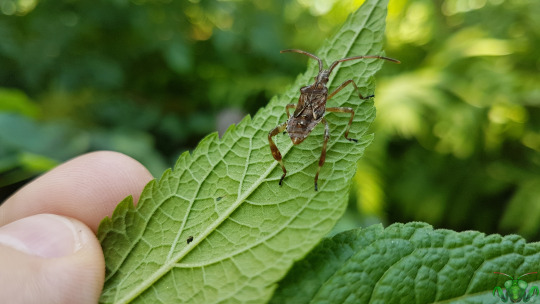


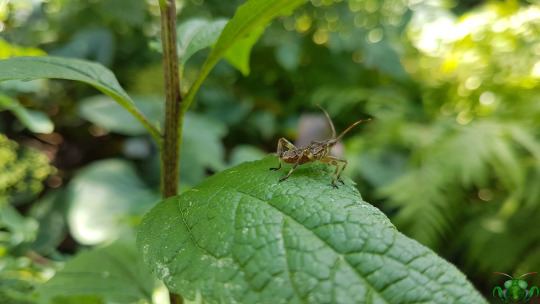

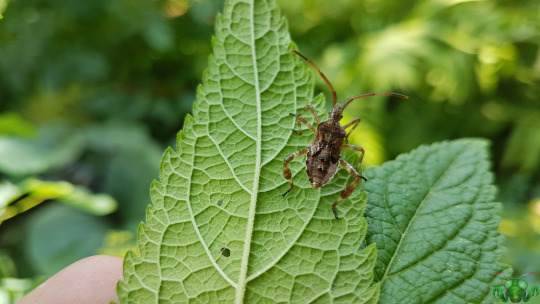


Conifer Seed Bug - Leptoglossus occidentalis
Looking at old favorites to revisit, I haven’t given the Western Conifer Seed Bug the large photography showcase that it deserves. Today is the start of that with a closer look at the nymph, and this specimen will return again by the end of the year with pictures of full grown adults as they navigate the wilderness. So, to the nymph! Like other Hemipterans/True Bugs, the Conifer Seed Bug nymph resembles the adult as it molts from instar to instar, growing larger with each molt. Based on comparisons to other L. occidentalis nymph images, I believe the individual here was a nymph in its 4th instar due to its size and proportions (5th is possible, but may be a stretch). The 4th instar means that this individual is two molts away from reaching full adulthood. I’m leaning more towards 4th instar as the images I’ve seen of the 5th instar tend to show the insects with colors and patterns closer to the adult (on the head and thorax), but it’s possible that this young one was freshly molted. Though small, the similarities are apparent between the young nymph and the adult specimen found just a week later. This nymph has the beginnings of the enlarged rear legs and the leaf-like shape near the foot.
This nymph here also has faint red eyes and banded striping along its legs and antennae that matches the patterning on the adult specimen. With comparisons between Pictures 1-9 and Picture 10, it may seem like a quantum leap to adulthood (especially in terms of size), but believe me it sneaks up on them quickly! Moreover, consider this: the eggs of the Conifer Seed Bug are so small that they can be laid on a pine needle. In fact, that how it usually goes as the main food resource of this insect is found on (and in) pine trees. Both nymphs and adults feed on the juice of a conifer tree’s green cones and the sap within using their rostrum to pierce and sip. Picture 5 offers a glimpse at this mouthpart when unfolded, but I doubt this individual would have much use for it with the plant it’s walking on. As to why this youngling isn’t in the pines above, my thought is that it fell on accident or dropped to escape something. With only wing buds it’ll be a big climb back up, but with a smell for pine in the antennae it could find its way back up among the pine cones and needles. That’s just for the summer to autumn over here, as when winter arrives, they overwinter outside or enter houses to seek warmth. If you find one, remember to catch it (rather than crush it, avoid the chemical defense) and put it outside.
Pictures of nymph were taken on August 11, 2019 with a Samsung Galaxy S7; Picture of adult was taken on August 19, 2019 with a Samsung Galaxy S4. A special thanks to my mother for loaning me her phone while mine was charging so that I could share these photos with you.
#jonny’s insect catalogue#ontario insect#leaf footed bug#conifer seed bug#true bug#hemiptera#heteroptera#insect#toronto#august2019#2019#entomology#nature#invertebrates
37 notes
·
View notes
Text

29.08.19
0 notes
Photo

View of Marseille from Fort Saint-Jean. August 2019 #fort #fortsaintjean #saintjean #marseille #france #france🇫🇷 #provence #southoffrance #southern #southernfrance #europe #travelling #august #august2019 #city #history #cars #boats #summer (at Fort Saint-Jean) https://www.instagram.com/p/CgkYqursifC/?igshid=NGJjMDIxMWI=
#fort#fortsaintjean#saintjean#marseille#france#france🇫🇷#provence#southoffrance#southern#southernfrance#europe#travelling#august#august2019#city#history#cars#boats#summer
0 notes
Photo

Simpliciaty August 2019
https://ifcasims.tumblr.com/post/619296538572816384/hair-dump-178cas-thumbnails-meshes-by
1 note
·
View note
Link
0 notes
Text
further job from trek challenges league for environment and conservation
further job from trek challenges league for environment and conservation, wersja robocza
dzeti for genres initiative_vxyq2309
there is lapidary note for scientific walk of life across for pioneering 100% campaign via continent explorings. expedition to be carry out to central orient from polish-latin nationality conservation advocate living nowadays in sweden, and french-based wildlife detective, author of the footprint of living beings. born to be wild is initiative from LBE and ECL league. continent grant for protect and research the nature is one of the initiatives from that. temki trademark zone is virtual concept for temki base for natural resources and growth by science in so-called european africa. the other are manufactured stuffs producted from weogu, the indopeuropean autonomic state from
region what is now xinjiang-kashgaria.swedish concept futurist is working currently for design about sci-fi vehicle working for wildlife genres monitoring and evaluate the ecologic status across wild orient and kaukasus. problematic projects are come from that. there is a concept of harmonic growth for innovations by saving the nature and explore the nowadays grants across wild orient, kaukasus and european-origin state in africa, following them.
QSBN EW29CJYDMAoDHCN august_2019sjaoc9/()=&¤10+4. adopted quatl pietrzak< specualtive fiction
heroes league for nature privilege in Europe
_: such as a working text
it is short intro about explore the undiscovered territories, wild places and living beings with their ecological requiremens and the humankind, ethnoworld and folk and business of wild orient and kaukasus, and for instance for working by demo projects for healthy environment, natural resources and resilient societies from european NGOs and european gov-agencies including the League of Environment Challenges, Vdem-he Toils, CEEweb for Biodiversity, ECOS and Livelihoods Funds. There is important job from helping private companies growing for better world across continent the Europe with the heritage and innovations, take a new standards in health of environment and looking for experts, whose take intuitive ventures launches for further generations.
<<further key facts<<
¤The world in the future - 5 innovations that will change our lives - Everything about the topic
¤Człowiek przyszłości? NaukowoTV
¤Human rights and freedom of conscience at portal of Life Gate
adopted quatl pietrzak_:30aEFTndwoq august2019
link: https://quatlnotesdraw04.creatorlink.net/ABOUT
1 note
·
View note
Photo

#damstredet #sthanshaugen #oslo #norway #august2019 (at Damstredet, Oslo) https://www.instagram.com/p/CUITGesIITK/?utm_medium=tumblr
10 notes
·
View notes
Text


From my Instagram @creature.marie
#me#mine#2019#august2019#angelic#wicca#witchcraft#pastel#fashion#softgoth#grunge#softgrunge#grungegirl#hair#hair ribbon#hair corset#pentagram#pink#roses#dried flowers#prairie goth#prairie#white lace#goth#gothgirl#alternative#angelic fashion#nicole dollanganger#fairycore#1k
2K notes
·
View notes
Photo

2019-08-25 18:58:23 #nikond3200 #nikond3200photography #nikkor16_80mm #summer #august #august2019 #ivanofrankivsk #carpathians #yaremche #river #waterfall #probiywaterfall #landscape (Водоспад Пробій) https://www.instagram.com/p/CTQ99GWjST9/?utm_medium=tumblr
#nikond3200#nikond3200photography#nikkor16_80mm#summer#august#august2019#ivanofrankivsk#carpathians#yaremche#river#waterfall#probiywaterfall#landscape
1 note
·
View note
Photo

Ashe 🏹
#fire emblem#fe3h#Fire Emblem Three Houses#feh#fe#ashe#Illustration#digital art#digital drawing#august#august2019#myart#fanart#artwork#art
1K notes
·
View notes
Text
Insect Songs: Dog-Day Cicada - Neotibicen canicularis & Black-Legged Meadow Katydid - Orchelimum nigripes
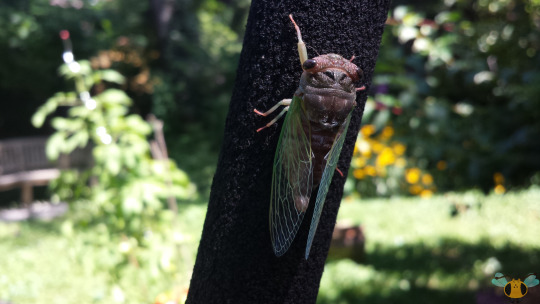
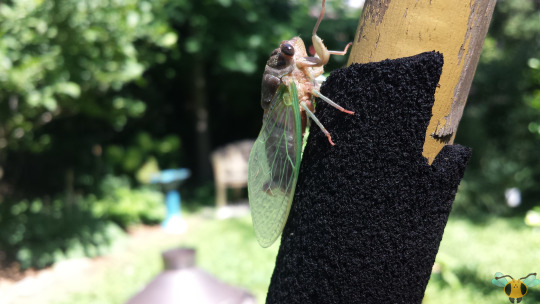

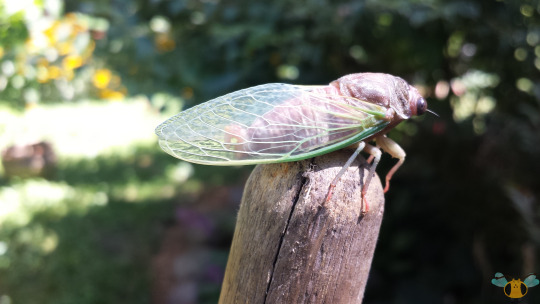
In today's exploration of insects and their songs, we 2 familiar species today that are quite prevalent in Ontario's summer months. We begin with the tree-dwelling shriekers that seem to grow even louder when heat increases. Just as with Crickets and other Orthopterans, the large-bodied Cicadas only sing if they are male. To produce their sound, they rapidly expand and contract a membrane behind their thorax called a tymbal. Knowing this information, you can actually identify males and female by looking for the tymbals, which (in this specie) is located underneath the wing. Be very gentle when handling a Cicada in order to see this tymbal, and if it screeches in response, it's definitely a male. That said, unlike Orthopterous insects, Cicadas do not use stridulation to produce their song, as that process describes insects rub certain body parts together (e.g. see below) to produce sound. Vibrating a membrane doesn't match the description. If anything, it's more like flexing a muscle and allowing the hollow-filled body to amplify the sound so that all can hear it.
Pictured below is a typical example of how a Cicada song normally appears in audio form. It is a distinct, clear sound. Headphone warning, a Cicada shriek can be very shrill, even if the audio has been gently reduced.

As mentioned in this blog's 100th post, the Cicada's song appears continuous because of the tremendously rapid expansion and contraction of this membrane. The muscles controlling the membrane are so powerful that the tymbal can vibrate several hundred times per second. The faster the vibration builds (for this specie), the higher the pitch of the song becomes. That said, just as a Cricket's chirp can be isolated to clicks, a Cicada's song can be slowed down to hear the individual pulses. After slowing the screeching down by several hundred times, this is the result:
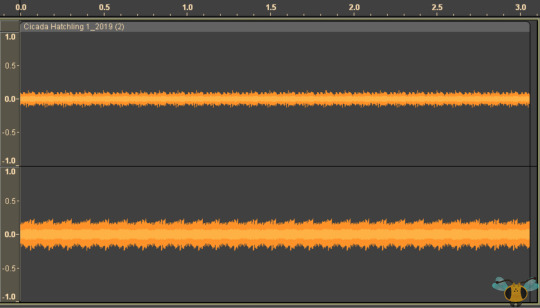
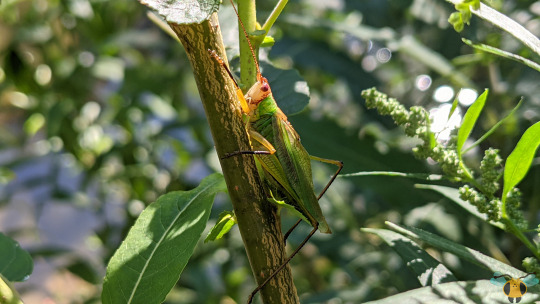

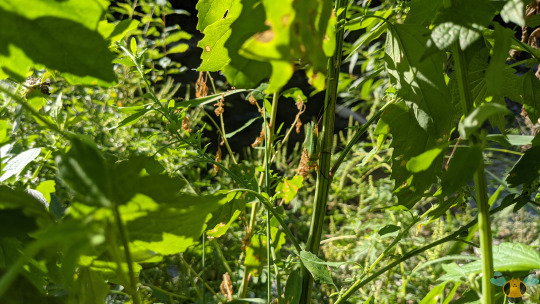
On the other side of the summer of insects, most Katydids generate their mating calls using wing-to-wing stridulation. There are exceptions of course (such as the Drumming Katydid), but today's specie has a loud method of communication! Like its Cricket friends, the loud, continuous sound is many clicks in rapid-succession. In fact, you can actually hear the beginnings of the clicks at the start of the song before the wings suddenly accelerate and make the call distinctive. Considered the role flight muscles play in controlling the wings and their noises, it's no surprise how the song can suddenly turn loud. It's very likely that the song can only be sustained in short bursts to prevent muscle damage or heat buildup, which is to say nothing of exposing oneself to a predator. The sound is alluring, for both mate and hunter alike. Pictured below is a typical example of the Black-Legged Meadow Katydid's song (headphone warning):
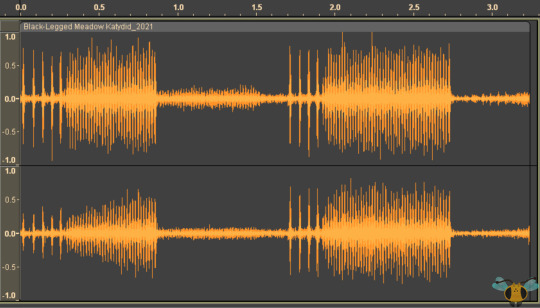
Do note, that while this is louder compared to the Cicada song, I was much closer to the source. If I was next to a singing Cicada, that too would have been an incredible amount of decibels! Nevertheless, when this Katydid's song is slowed down, the individual clicks become more prominent. Looking at it immediately after slowing the tempo down a few hundred times, a quick burst of less that one second becomes nearly 45 seconds of clicks! To showcase this, I've included a "portal" that offers a zoomed in look at the slowed song. Each spike in amplitude is a click of the wing-scraping. Even at reduce speed, you can hear the gradual acceleration of the clicking as the song goes on (headphone warning):

Pictures were taken on August 24, 2019 (Dog-Day Cicada) with a Samsung Galaxy S4 and on September 5, 2021 (Meadow Katydid) with a Google Pixel 4. Audio amplitude graphs were created using Audacity and samples from the following blog videos:
Black Legged Meadow Katydid | Dog-day Cicada
#jonny’s insect catalogue#ontario insect#cicada#dog day cicada#katydid#bush cricket#black legged meadow katydid#orthoptera#hemiptera#auchenorrhyncha#true bug#insect#insect audio#toronto#august2019#2019#september2021#2021#insect clicking#insect noise#a closer look#insect chirping#nature#entomology#invertebrates
5 notes
·
View notes
Photo

Instagram Story | 31st August 2019
0 notes
Photo

One of my favourite places in the world. Along the Promenade Des Anglais in Nice. August 2019 #nice #france #france🇫🇷 #europe #nicefrance #promenadedesanglais #avenue #beach #mediterranean #themed #august #august2019 #europe #mono #monochrome #blackandwhitephotography #blackandwhite #bnwmood #streetphotography #street #people (at Nice, France) https://www.instagram.com/p/CgkRp9fMka2/?igshid=NGJjMDIxMWI=
#nice#france#france🇫🇷#europe#nicefrance#promenadedesanglais#avenue#beach#mediterranean#themed#august#august2019#mono#monochrome#blackandwhitephotography#blackandwhite#bnwmood#streetphotography#street#people
0 notes
Photo

“VIENI a Me…
… arDITAmente.”
Il Silente Loquace ©
339 notes
·
View notes
Video
Camila waving her arms at “Shawn Mendes The Tour” in Brooklyn.
1 note
·
View note